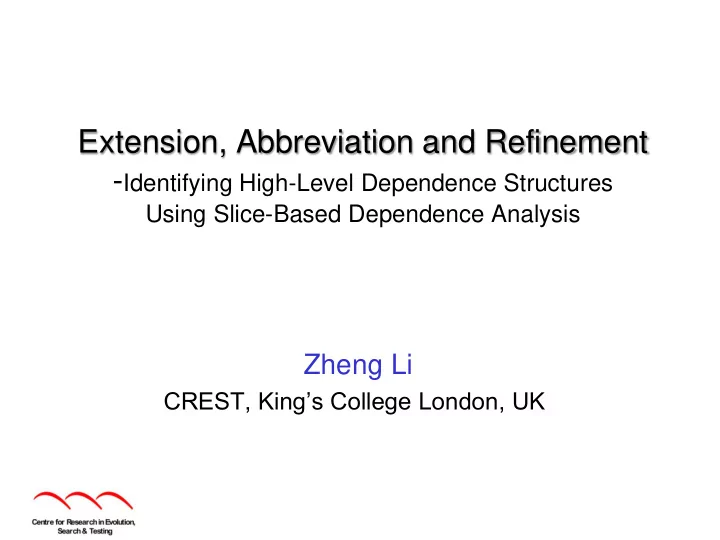

Extension, Abbreviation and Refinement - Identifying High-Level Dependence Structures Using Slice-Based Dependence Analysis Zheng Li CREST, King’s College London, UK
Overview • Motivation • Three combination techniques – Extension – Abbreviation – Refinement
Many analysis techniques for program comprehension have been proposed Domain knowledge Source code high-level low-level Pattern recognition Data-flow analysis Concept assignment Dependence analysis
Advantages and Disadvantages High-level Low-level Accuracy Low High Scalability Yes No Human Yes No Knowledge
If combine the two? • High-level techniques can provide a reasonable analysis scope with domain knowledge for low-level analysis techniques, then avoiding the scalability problem of low- level techniques. • Low-level techniques can improve the accuracy of high-level techniques.
In this thesis Concept Program Assignment Slicing
Concept Assignment • First defined in 1993 and aimed at comprehension tasks • allocate specific high-level meaning to specific parts of a program • Hypothesis-Based Concept Assignment (HB- CA) – Existing implementation – Uses domain and program semantics – Good quality assignments
Program Slicing which other lines affect the selected line? we only care about this line
Concept Assignment Program Slicing Contiguous? Executable? High/low level ?
Combination 1: Extension • Concept Slice – Using program slicing to ‘extend’ a concept binding by tracing its dependencies • Algorithm – Using concepts as slicing criteria, the concept slice is the union of slices for each program point in the concept
Combination 2: Abbreviation • Extract key statements within concept bindings Less is More! – The statements that capture most impact with highest cohesion – help to focus attention more rapidly on the core of a concept binding • Algorithm – Intersection of slices with respect to principal variables within a concept binding
r h D=2*r; perimeter=PI*D; undersurface=PI*r*r; sidesurface=perimeter*h; area=2*undersurface+sidesurface; volume=undersurface*h; printf(“ \nThe Area is %d\n", ); area printf(“ \nThe Volume is %d\n", ); volume
The Results so far The concept slice has no size explosion. The identified key statements have high Impact and Cohesion, but some concept bindings do not contain key statements.
Combination 3: Refinement A more accurate dependence based concept binding by removing non-concept-dependent statements
r h D=2*r; perimeter=PI*D; undersurface=PI*r*r; sidesurface=perimeter*h; area=2*undersurface+sidesurface; volume=undersurface*h; printf (“ \nThe Area is %d\n", area); printf (“ \nThe Volume is %d\n", volume);
Program Chopping Given source S and target T , what program points transmit effects from S to T ? S T
Vertex Rank Model • Google’s Page Rank Model • Dependence is transitive • the weight of a vertex will be distributed following the outgoing edges and inherited through incoming edges.
Weight of Nodes • sum of all node weights = 1 • weight of node represents the importance of dependence of a vertex
Weights of Edges 0.05 0.2 d =1/4 0.05 d =1/4 0.05 A B 0.4 0.2 d =1/4 0.05 d =1/4 0.15 0.05 d : distribution ratio • Node weight is distributed to each outgoing edge • Edge weights are collected at the destination node • sum of all outgoing edge weights = origin node weight • sum of all incoming edge weights = destination node weight
Definition of Weights t w ( v ) w ( v ) d d d 1 1 11 12 1 n w ( v ) d d d w ( v ) . = 21 22 2 n 2 2 d d d w ( v ) w ( v ) n 1 n 2 nn n n W : node weight vector D t : transposed matrix of distribution ratios
Propagating Weights 0.34 0.33 0.17 A B 0.17 0.33 0.33 0.33 C
Propagating Weights 0.33 0.17 0.175 A B 0.175 0.5 0.17 0.5 C
Propagating Weights 0.5 0.175 0.25 A B 0.25 0.345 0.175 0.345 C
Propagating Weights 0.4 0.2 0.2 A B 0.2 0.4 0.2 0.4 C • Stable weight assignment – next-step weights are the same as previous ones
Pseudo Use Relation A B C • Weight computation does not always converge • Add a pseudo edge from a node to another, if there is no 'real' edge • Distribution ratios: pseudo edges << real edges
Empirical Study • Tools – WeSCA and CodeSurfer • 10 Subject programs – Open source and industry code – More than 600 concept bindings are extracted • Dependence based metrics are defined • Statistical analysis
Size reduction
Impact
Cohesion
Summary • The combination of approaches can be fully automated and implemented. • Concept refinement is better than concept extension and concept abbreviation.
Questions?
Recommend
More recommend